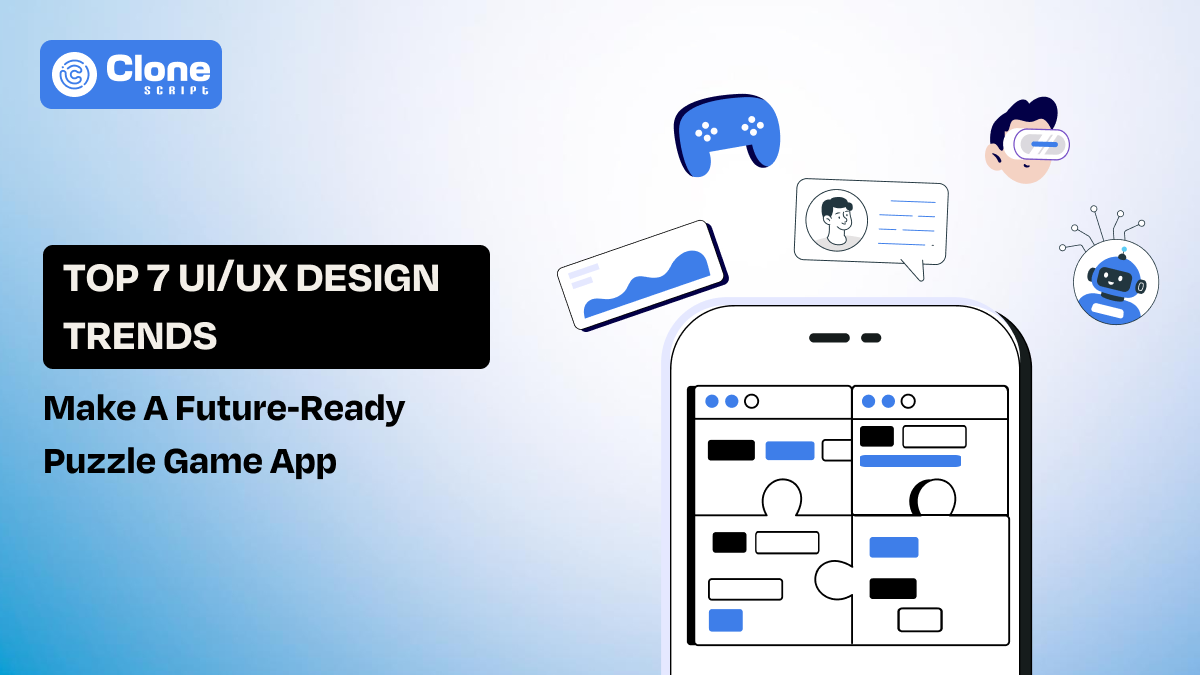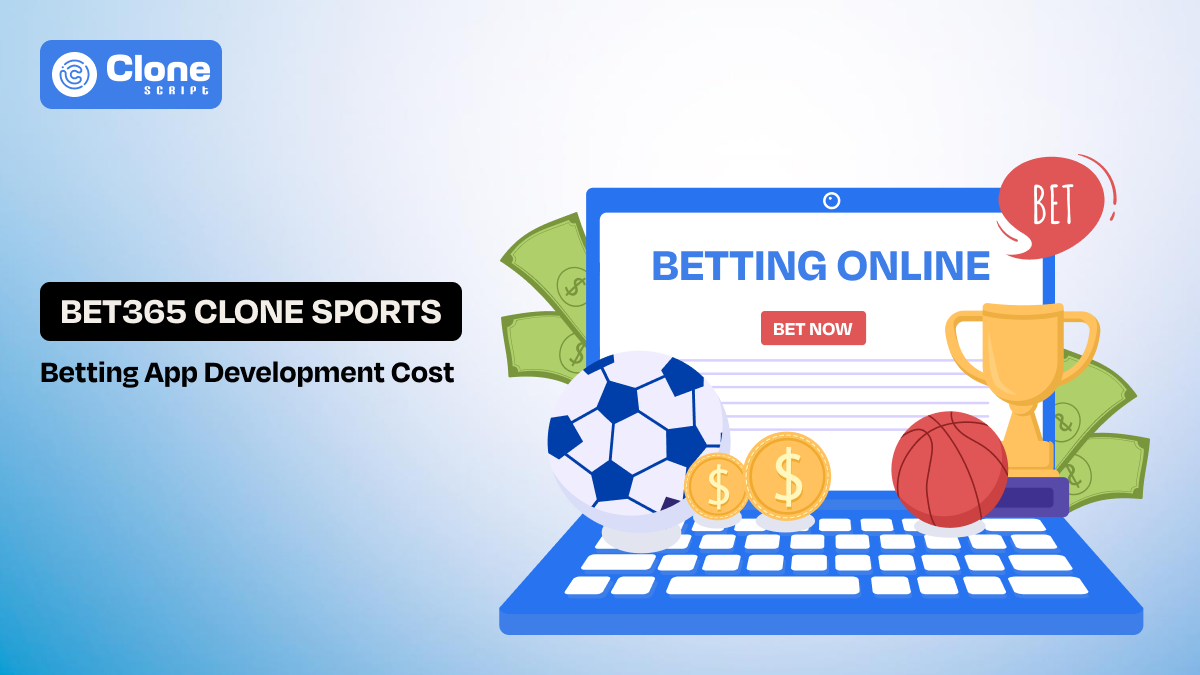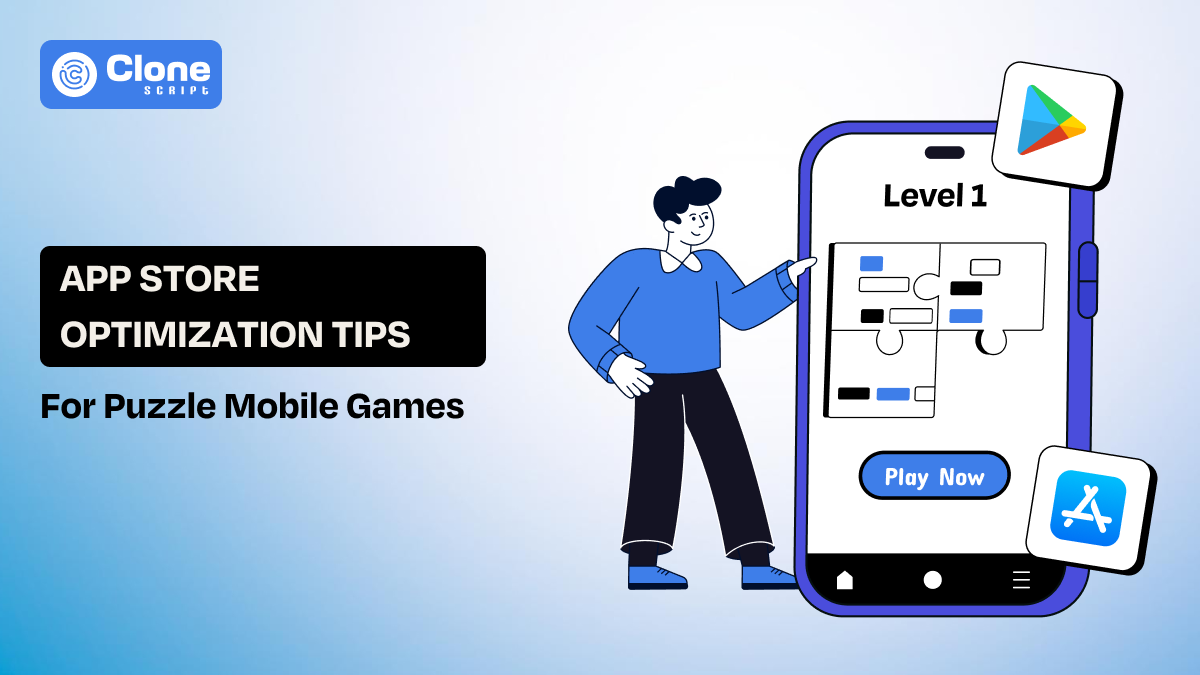Top 7 Game Design Trends for Puzzle Game Apps
Here’s a fun fact to puzzle over: according to a report, over 63% of all mobile gamers play puzzle games every week, yet less than 5.35% of those games hold players’ attention beyond 30 days.
Now, that’s not just a statistic—it’s a survival rate worthy of a mystery novel.
Why such a drastic drop?
Because a good puzzle game doesn’t just test logic; it tests patience, attention, and emotion. The best ones don’t simply challenge you—they charm you, tease you, and reward you. They understand human behavior better than you ever did.
Designing a great puzzle game app with UI/UX tips isn’t just about connecting tiles or matching colors. It’s about connecting emotions. And that’s where the art of app design trends comes in.
Let’s explore the top 7 puzzle game design trends that are reshaping how we play, feel, and even think in 2025.
Importance of Game Design in Puzzle Game Apps
Think of puzzle game design as the invisible hand that guides the player’s joy (and occasional frustration). You might not see it, but you feel it.
A beautifully designed mobile puzzle game UX design ensures players don’t rage-quit after five minutes. Instead, they flow effortlessly from one challenge to another, feeling a sense of “I’ve got this!” even when they definitely don’t.
-
Keep note that design dictates emotion. From the minimal and subtle tilt of an icon to the rhythm of a level transition, every pixel tells a story.
In fact, studies show that games with intuitive design and smoother difficulty curves enjoy 37% higher retention rates.
So yes. Great design doesn’t just look good; it keeps your audience glued to their screens, whispering, “Just one more level.”
7 Must-Have Design Trends in Puzzle Game Apps
Whenever you revamp the existing game design or make a new app, keep these trends for more engagement from players:
1. Minimalist UI With Intuitive Puzzle Game Flow Improves Engagement.
Clutter is the prime enemy of focus. That’s why the minimalist user interface (UI) is leading the pack in mobile puzzle game trends.
Gone are the days of neon buttons, flashing banners, and 12 different icons yelling for attention.
Modern puzzle games whisper instead of shouting. They use neutral tones, clean typography, and white space that let the puzzle itself take center stage.
-
Take the example of the Monument Valley game. How simplicity wins always. Its design doesn’t tell you what to do; it shows you. The experience feels like meditation disguised as gameplay.
A minimalist design improves puzzle game UX by reducing cognitive overload. This makes sure the player’s brain focuses on solving puzzles, not evaluating the interface.
2. AI and Smart Puzzle Level Design Will Help.
If design is the body, intelligence is the brain.
And here’s the twist: AI personalization puzzle games aren’t about replacing creativity; they’re about amplifying it.
Imagine a game that quietly learns how you play: how long you hesitate, where you stumble, and what makes you rage-tap the screen. Then it adjusts the next challenge just enough to make you feel smart again.
That’s the power of adaptive design.
You may not believe. 25% of longer play sessions have been reported when games use AI-driven balance in gameplay.
-
The key is subtlety. From the gaming behavior to the dynamic playing conditions favoring your app to be prioritized.
Note that players shouldn’t notice the game adapting to them. It should feel like destiny. Or at least, a very smart coincidence.
3. Haptic Feedback & Micro-Interactions: The Satisfying "Click."
Let’s be honest: half the fun of solving puzzles is that tiny “click” when everything locks into place.
Is that satisfying when you win a level? That’s haptic feedback. The minimalist, specific vibration you feel and it’s one of the unsung heroes of engaging puzzle game design.
How can we forget a micro-interactions importance in success? They are smooth transitions, button ripples, or subtle animations. You can say them a game designer’s equivalent of seasoning in a gourmet meal. You don’t always notice them, but without them, something feels... bland.
-
Every micro-interaction creates an emotional connection. It’s the difference between “I finished a level” and “I nailed it!”
In short, great micro-feedback is invisible design done right, and your players’ thumbs will thank you for it.
4. AR and Mixed Reality Puzzle Game Experiences Sound Futuristic.
Augmented Reality (AR) has stepped out of the “gimmick” phase and straight into the spotlight.
Today’s puzzle game development involves turning your coffee table into a game board and your living room into a puzzle arena.
Take ARise or PuzzlAR, which let players physically move around objects to solve mind-bending challenges.
The result?
An experience that feels like magic—because, well, it kind of is.
-
AR combines the virtual and real, offering players a deeper sense of immersion and exploration. It’s not just about seeing a puzzle; it’s about living inside one.
As mixed reality continues to grow, expect mobile puzzle game trends to merge with real-world interactivity in ways that make “screen time” feel like adventure time.
Those days are gone when a player had to download the game from the Play Store and start playing the 2D game. Now, it’s time to go beyond expectations.
5. Narrative-driven Puzzle Game Mechanics Feel Personal.
What is the difference between a good puzzle game and a great one?
A good game makes you think, and the best game convinces you to feel.
That’s where narrative-driven puzzle design comes.
It means value for the player’s actions. You’re not just rotating shapes or unlocking tiles. But, you’re uncovering a story, rebuilding memories, or saving a tiny character from existential doom (looking at you, Monument Valley II).
This trend marries emotion with logic.
-
Players come with purpose, not just to earn points and rewards. When storytelling becomes part of the puzzle, every solution feels like a small emotional win.
Games like The Room and Gorogoa prove that storytelling in puzzle game UX transforms puzzles from simple challenges into soulful experiences.
6. Cross-platform Gameplay and Cloud Saves Contribute to Global Presence.
Here’s the deal: gamers today want to start a level on their phone, continue it on a tablet, and finish it on their smart fridge (we’re halfway there, honestly).
Cross-platform play and cloud saves aren’t luxuries anymore. They become expectations now.
Designers focusing on cross-device puzzle game UX design ensure seamless transitions without progress loss or jarring visual differences.
A report found that cross-platform games see 30% higher daily active user engagement.
What does that mean?
Players love flexibility. They never like to complete the level on a smartphone. But prefer to continue on other devices when they leave.
After all, the only thing worse than getting stuck on a hard puzzle is losing your progress on it.
7. Gamified UI Elements and Achievements Encourage More Play.
We humans love shiny rewards. It’s why we check emails compulsively, collect loyalty points, and celebrate when our fitness app tells us we walked 0.01 miles more than yesterday.
Those kinds of feelings prove to be a key aspect of any puzzle game for player retention.
Gamified UI elements like progress bars, leaderboards, or collectible badges transform effort into celebration.
-
When done tastefully, gamification keeps players coming back not out of obligation but out of curiosity and joy. It aligns perfectly with modern monetization trends for puzzle games, encouraging engagement while subtly enhancing retention.
Gamified design isn’t manipulation, it’s motivation. A gentle nudge that says, “Hey, you’re doing great—want to see what’s next?” will convey the message for a longer gameplay.
How to Design a Brilliant Puzzle Game App Fast and Easily?
Creating a puzzle game doesn’t mean you have to reinvent the wheel or the grid creation manually.
Now, smart solutions help the development team make the best app.
Here is the app UI kit designed in Figma, which you can use for a puzzle and a crossword puzzle game.
-
Jigsaw Puzzle Game App UI Kit
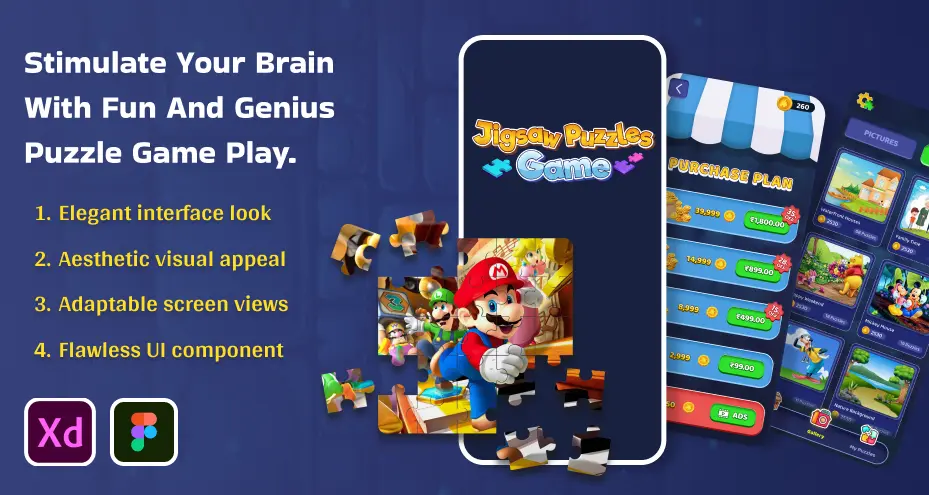
-
Crossword Game App UI Kit
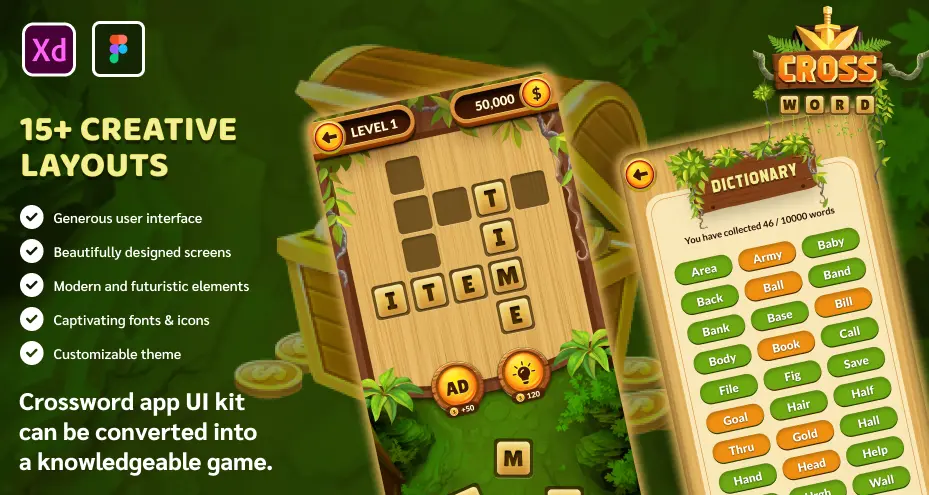
You can skip tedious design setups and jump straight to creativity.
These kits offer ready-to-use puzzle game UI ideas that align with modern features and the latest UX trends.
Whether you’re designing a relaxing jigsaw or a mind-bending crossword app, these tools let you focus on the fun part, crafting experiences that make players say, “Just one more round.”
Conclusion
In the end, puzzle games are about more than solving problems. They’re about feeling smart while having fun.
Whether it’s the quiet satisfaction of a clean interface, the thrill of an adaptive level, or the emotional pull of a story, the future of puzzle game design trends remains in the harmony of simplicity, intelligence, and emotion.
So, if you’re designing the next big puzzle hit. Keep it human, keep it intuitive, and above all, keep it joyful.
Because the best puzzle games don’t just challenge minds. They connect emotions.
FAQs
-
What key features should I include in a puzzle game app to boost player engagement?
Focus on intuitive UI, adaptive levels, rewarding sound effects, and social sharing options. Integrate micro-interactions and gamified achievements to keep players emotionally invested and returning frequently.
-
How do I design a mobile puzzle game UX design that feels intuitive and satisfying?
Use minimalist layouts, predictable navigation, and clear feedback cues. The best mobile puzzle game UX design reduces frustration, where every tap, swipe, and sound should feel natural and rewarding.
-
Which monetization strategies work best for puzzle game apps in 2025?
Combine ad-supported free play with optional premium features and reward-based purchases. Subscription models and event-driven content are dominating monetization for puzzle games this year.
-
How can I practically integrate AI-driven adaptive difficulty into my puzzle game?
Use player performance data to adjust puzzle complexity dynamically. Adaptive difficulty keeps engagement high by ensuring challenges stay fair, rewarding, and personalized for each player’s skill level.
-
What are the technical requirements or best practices for implementing AR in mobile puzzle games?
Implement AR using ARKit or ARCore. Focus on stable tracking, lightweight assets, and intuitive interaction design to blend physical and virtual elements seamlessly in mobile puzzle experiences.
-
Are the Figma UI kits customizable for different art styles and branding needs?
Yes, Figma UI kits are fully customizable. It allows designers to adjust colors, typography, and layout easily to match different branding needs, themes, and art styles.
 BTC - Bitcoin
BTC - Bitcoin
 USDTERC20 - USDT ERC20
USDTERC20 - USDT ERC20
 ETH - Ethereum
ETH - Ethereum
 BNB - Binance
BNB - Binance
 BCH - Bitcoin Cash
BCH - Bitcoin Cash
 DOGE - Dogecoin
DOGE - Dogecoin
 TRX - TRON
TRX - TRON
 USDTTRC20 - USD TRC20
USDTTRC20 - USD TRC20
 LTC - LiteCoin
LTC - LiteCoin

